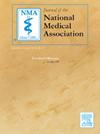The impact of NIH funding and program reputation score on research output and residency matches in neurosurgery: A bibliometrics analysis
IF 2.5
4区 医学
Q1 MEDICINE, GENERAL & INTERNAL
引用次数: 0
Abstract
The neurosurgery residency applicant selection process is complex, with peer-reviewed publications (PRP) recently becoming a key focus. While PRP may significantly impact applicant matching, equitable opportunities for research may vary for students. We aimed to evaluate the impact of NIH funding and program reputation score on applicants’ ability to match into top neurosurgery residency programs. Successfully matched PGY1 neurosurgery applicants in the 2022-2023 cycle were evaluated. PRP, Blue Ridge Institute for Medical Research (BRIMR) medical school and residency NIH-funding ranking, and residency Doximity reputation score were evaluated. PGY1 residents (n = 235, 73% male) included 84% MDs, 1.0% DO, 10% MD/PhD, and 5% IMGs. Thirty-one (13.2%) superpublishers (> 25 PRPs) were identified (93.5% male) and had a higher number of non-MD degrees (32.3% vs. 13.3%, p = 0.007). Matching into a top 20 NIH-ranked residency program was associated with completion of a top 20 NIH-medical program (OR = 2.70, p = 0.015), superpublisher status (OR = 2.87, p = 0.024), and affiliation with a top 40 NIH-ranked neurosurgery program (OR = 3.44, p < 0.001). Matching into a top 40 reputation program was predicted by being a superpublisher (≥ 25 publications; OR = 2.66, p = 0.04) and attending a medical school with an affiliated top 40 reputation neurosurgery program (OR = 4.85, p < 0.001). PRP has become a large focus in determining a candidate's competitiveness for top neurosurgery residency programs. Our results clarify the factors impacting PRP, including the importance of NIH funding and the neurosurgery department's reputation. These results highlight both best practices for training residents and potential disadvantages some medical school candidates may have from lower-ranked programs or limited research opportunities. Further studies are warranted to evaluate the impact of these factors on the equity of neurosurgery residency candidates.
美国国立卫生研究院资助和项目声誉评分对神经外科研究产出和住院医师匹配的影响:文献计量学分析。
神经外科住院医师申请人的选择过程是复杂的,同行评议的出版物(PRP)最近成为一个关键焦点。虽然PRP可能会显著影响申请人匹配,但公平的研究机会可能会因学生而异。我们的目的是评估NIH资助和项目声誉评分对申请人匹配顶级神经外科住院医师项目的能力的影响。评估2022-2023周期成功匹配的PGY1神经外科申请人。评估PRP、蓝岭医学研究所(BRIMR)医学院和住院医师nih资助排名以及住院医师邻近声誉评分。PGY1居民(n = 235,73%男性)包括84% MD, 1.0% DO, 10% MD/PhD和5% img。31名(13.2%)超级出版商(bbbb25名PRPs)(93.5%为男性),非医学博士学位的人数较多(32.3% vs. 13.3%, p = 0.007)。匹配到前20名NIH-ranked实习计划与完成前20名NIH-medical程序(或 = 2.70,p = 0.015),superpublisher状态(或 = 2.87,p = 0.024),和联系前40名NIH-ranked神经外科程序(或 = 3.44,p < 0.001)。通过成为超级出版者(≥25篇出版物;OR = 2.66,p = 0.04),并且就读于拥有排名前40的神经外科专业的医学院(OR = 4.85,p < 0.001)。PRP已经成为决定候选人在顶级神经外科住院医师项目中的竞争力的一个重点。我们的研究结果阐明了影响PRP的因素,包括NIH资助和神经外科声誉的重要性。这些结果强调了培训住院医师的最佳实践,以及一些医学院候选人可能从排名较低的项目或有限的研究机会中面临的潜在劣势。需要进一步的研究来评估这些因素对神经外科住院医师候选人公平性的影响。
本文章由计算机程序翻译,如有差异,请以英文原文为准。
求助全文
约1分钟内获得全文
求助全文
来源期刊
CiteScore
4.80
自引率
3.00%
发文量
139
审稿时长
98 days
期刊介绍:
Journal of the National Medical Association, the official journal of the National Medical Association, is a peer-reviewed publication whose purpose is to address medical care disparities of persons of African descent.
The Journal of the National Medical Association is focused on specialized clinical research activities related to the health problems of African Americans and other minority groups. Special emphasis is placed on the application of medical science to improve the healthcare of underserved populations both in the United States and abroad. The Journal has the following objectives: (1) to expand the base of original peer-reviewed literature and the quality of that research on the topic of minority health; (2) to provide greater dissemination of this research; (3) to offer appropriate and timely recognition of the significant contributions of physicians who serve these populations; and (4) to promote engagement by member and non-member physicians in the overall goals and objectives of the National Medical Association.

 求助内容:
求助内容: 应助结果提醒方式:
应助结果提醒方式:


